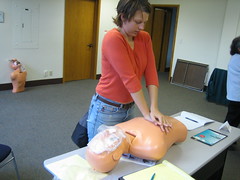 It’s dry. It’s boring. It’s dead — or deadly. It’s nonprofit writing! Not all nonprofit writing, of course, but a fair amount of it.
It’s dry. It’s boring. It’s dead — or deadly. It’s nonprofit writing! Not all nonprofit writing, of course, but a fair amount of it.
Here are 20 ways you can bring your writing back to life.
1. Use more descriptive nouns and verbs. Don’t say child when you can say teenager or toddler or even 16-year-old or 3-year-old.
2. Add short anecdotes or stories. People often need an example to understand what you are talking about. Share a brief story to make your theories or generic language more real.
3. Use analogies or metaphors. It’s easier to explain a new idea when you connect it to an old one that people already understand. I’ve written an entire e-book on using metaphors in nonprofit writing and you can download it as a free member of our Learning Center.
4. Talk it out. How would you say it out loud? Pretend that you are giving a two-minute presentation on your topic. Practice it a few times. Then go back and write.
5. Cut it in half. Enough already! You very well may have great content written, but you’ve buried it. Cut your words in half and see if the meaning comes to life.
6. Add a timely reference. By talking about something in the news, you let your reader know that you are writing here and now, which is always more interesting than something that could have been written ten years ago.
7. Show some humility. Let us know what went wrong. People who admit their mistakes or faults are always more interesting than perfect people.
8. Edit your cutting and pasting. While I’m all for repurposing content, it does require editing. If you are constantly cutting and pasting text without editing it for its new purpose, it’s going to feel old and worn out eventually.
9. Add a beginning, middle, and end. It’s easier to stay involved in what we are reading if we feel like we are going somewhere.
10. Vary the length of your sentences. Mix sentences of just a few words with some longer ones. The short sentences add a little pop to the longer ones.
11. Add a cultural reference. Mentioning a popular TV show or other cultural reference can help connect you to your audience (but this requires that you know your audience, so most people will get it).
12. Think of problems and solutions. People like figuring our puzzles and solving problems. Presenting your topic in this way can give it some extra oomph.
13. Make the reason you are writing crystal clear. We often think something is boring simply because we don’t understand its relevance to our lives. Be clear and upfront about your purpose and its meaning.
14. Cut out the irrelevant details. If you give too many details, it’s distracting.
15. Try a visual instead. Maybe what your writing really needs is a photo or a graphic. They are worth 1,000 words, you know.
16. Compare or contrast. Give your reader some perspective by comparing what you are talking about to something else they are already familiar with.
17. Mind map it. Maybe you haven’t found the right angle yet. Mind mapping is a tool that helps you think of related topics and angles.
18. Push the boring stuff to a sidebar. If there’s just no way to make something more interesting, put it in a box or sidebar or link to it on another page of your website. Get it out of the way of your main message.
19. Go back to your audience. Is this really what they need from you? Or are you trying to do too much, or making bad assumptions about them?
20. Give yourself some time. Put it down and come back to it later, ideally at least a day later. It’s hard to write well when you are stressed out or bored.
P.S. Claire Meyerhoff and I will be talking about nonprofit writing and specifically writing for fundraising on our Magic Keys Radio and Podcast tomorrow (Friday, 1/14/11, live at 1:00 ET, available as a podcast right after). Our guest will be Sam Caldwell with the Planned Giving Company.






